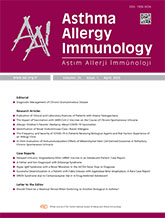


Objective: Ataxia-telangiectasia is a rare genetically inherited disease with multisystem involvement. We evaluated the clinical and laboratory features of patients diagnosed in our clinic with ataxia-telangiectasia.
Materials and Methods: The files of children diagnosed with ataxia-telangiectasia in our clinic between 2008 and 2021 were evaluated retrospectively.
Results: Twelve children diagnosed with ataxia-telangiectasia were included in the study. Fifty percent of our patients were boys, and 50% were girls. There was a family history of ataxia-telangiectasia in seven patients and consanguineous marriage between the parents of 11 patients. The mean age at diagnosis of the patients was 5.5 years. Our cases had telangiectasia in the conjunctiva (n=8), a nevus (n=5), cafe-au-lait spots (n=5), hypopigmentation (n=4), and skin telangiectasia (n=3). Eosinophilia (n=1), lymphopenia (n=7), and neutropenia (n=1) were also found. Our patients were determined to be below -2 SD for age in terms of IgE levels in 25%, IgA levels in 58.3%, and IgG levels in 8.3%. Antibody responses were negative for anti-hepatitis B surface (HBs) IgG (n=5), anti-measles IgG (n=7), anti-mumps IgG (n=6), anti-VZV IgG (n=6), anti-tetanus IgG (n=6), and anti-hepatitis A virus IgG (n=3). Seven patients had homozygous ataxia-telangiectasia gene (ATM) mutations. We most commonly detected homozygous c.4940T>G (p.L1647R) and homozygous c.6047A>G (p.D2016) mutations. Alpha-fetoprotein (AFP) levels were elevated in all patients. We started intravenous immunoglobulin (IVIG) therapy for 10 patients.
Conclusion: Ataxia and telangiectasia were the most common findings of the disease, followed by immunological findings, growth retardation, and pigmentation abnormalities.